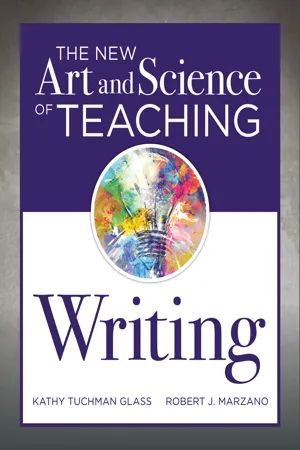
The New Art and Science of Teaching
(Research-Based Instructional Strategies for Teaching and Assessing Writing Skills)
- 192 pages
- English
- ePUB (mobile friendly)
- Available on iOS & Android
The New Art and Science of Teaching
(Research-Based Instructional Strategies for Teaching and Assessing Writing Skills)
About This Book
For educators to be effective, they must intentionally select and implement research-based instructional strategies and conduct assessments. Using a clear and well-organized structure, the authors apply the strategies and techniques originally presented in The New Art and Science of Teaching by Robert J. Marzano to the teaching and assessment of writing skills, as well as some associated reading skills. In total, the book shares more than 100 strategies across grade levels and subject areas.
Use effective teaching methods to reach desired writing learning outcomes and student success:
- Understand which instructional strategies are best suited to teaching writing skills, and gain specific examples for implementing these strategies.
- Learn how to utilize general and specific strategies to improve the learning environment of the classroom and obtain desired student learning outcomes for writing.
- Fine-tune your writing curriculum to achieve student success by developing and assessing writing skills with the book's instructional techniques.
- Examine samples of writing rubrics, proficiency scales, and checklists, and learn effective teaching methods to use them as assessment and instructional tools.
- Utilize an advance organizer as a quick reference of all strategies to assist you in designing writing curriculum and planning lessons.
- Access and download free reproducible activities, rubrics for assessing student writing, writing assessment examples, writing checklists, and more for classroom use.
Contents:
Introduction
Chapter 1: Providing and Communicating Clear Learning Goals
Chapter 2: Using Assessments
Chapter 3: Conducting Direct Instruction Lessons
Chapter 4: Conducting Practicing and Deepening Lessons
Chapter 5: Conducting Knowledge Application Lessons
Chapter 6: Using Strategies That Appear in All Types of Lessons
Chapter 7: Using Engagement Strategies
Chapter 8: Implementing Rules and Procedures and Building Relationships
Chapter 9: Developing Expertise
Conclusion
Appendix A
Appendix B
References and Resources
Frequently asked questions
Information
Table of contents
- Cover
- Title Page
- Copyright
- Acknowledgments
- Table of Contents
- About the Authors
- Introduction
- Part I: Feedback
- Part II: Content
- Part III: Context
- Afterword
- Appendix A: Framework Overview
- Appendix B: List of Figures and Tables
- References and Resources
- Index